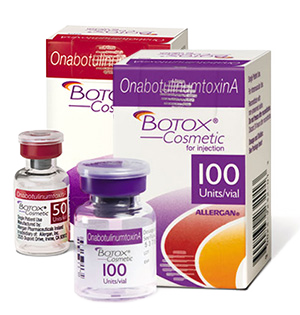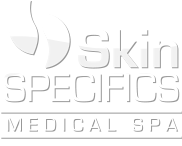What Is Botox?
 Botox® Cosmetic is a simple, non-surgical treatment that can temporarily smooth moderate to severe facial wrinkles in people from 18 to 65 years of age. According to the American Society of Plastic Surgeons®, botulinum toxin type A administrations were the number one minimally invasive cosmetic procedure administered in the United States in 2014, with 6.7 million procedures occurring that year. Botox® Cosmetic is the only treatment of its type approved by the Food and Drug Administration (FDA).
Botox® Cosmetic is a simple, non-surgical treatment that can temporarily smooth moderate to severe facial wrinkles in people from 18 to 65 years of age. According to the American Society of Plastic Surgeons®, botulinum toxin type A administrations were the number one minimally invasive cosmetic procedure administered in the United States in 2014, with 6.7 million procedures occurring that year. Botox® Cosmetic is the only treatment of its type approved by the Food and Drug Administration (FDA).
This treatment takes about 10 minutes and consists of a few small injections. Within days this procedure creates a noticeable improvement in moderate to severe frown lines between the brows. The results of this short procedure can last for up to 4 months. Results may vary. At Skin Specifics Medical Spa, we use Botox® Cosmetic to decrease the severity of facial lines, lines between the brows, forehead lines, and around the eyes (crow’s feet).
Common Uses For Botox
- Wrinkles in Facial Skin
- Gum-Revealing Smile
- Excessive Sweating
- Neck Spasms
Treatments We Offer
Treat Facial Wrinkles
Botox is not permanent and its administration is ideally repeated multiple times throughout the years to achieve the best outcome.
Everyone gets wrinkles—even those who take exemplary care of their skin by applying sunscreen, staying out of the sun when possible, or implementing a skincare regimen. Dynamic wrinkles, which are caused by routine muscle movement, are the result of actions such as smiling, squinting in a bright light, and laughing… In other words, living your life! Botox is an ideal non-surgical process to manage the unwelcome side effects of a healthy, happy life. We use Botox on the upper and lower face as well as the neck. We also use it to shape the jawline. Most of our clients receive Botox for both prevention and treatment of wrinkles and are very happy with the results!
Diminish the Appearance of Gums
Botox can be used to lengthen the upper lip and drop it down slightly, in order to reduce the appearance of the gums when smiling. The success of this procedure depends on the original length of the lip and prominence of the gums, and is only ideal for certain patients.
Reduce Excessive Sweating
Some people experience excessive sweating under their arms, which is also known as hyperhidrosis of the axillae. For the most part, this can be resolved using deodorants, antiperspirant creams, or gels. However, when topical treatments do not resolve this condition, Botox can be injected into the underarm area to reduce the activity of the local sweat glands.
Lift Breasts
We can lift breasts that have minor sagging by injecting Botox into the pectoralis minor, which is the muscle that sits under the pectoralis major (commonly known as “pects”). This procedure will not reduce or augment a patient’s breast size, change their shape, or be beneficial in cases of major sagging.
Address an Overactive Bladder
Botox can be administered to address Overactive Bladder Syndrome (OBS). It is only used to help patients who urinate more than twice overnight and upwards of eight times daily. In these cases, a Botox injection sends a physiological sign to the muscle that controls the bladder, reducing the frequency of the patient’s feeling that he or she needs to urinate.
Lessen Neck Spasms
To treat recurring neck spasms, Botox is administered to the nerves of the neck via injection, which causes the corresponding muscles to loosen. This procedure reduces the frequency and intensity of a patient’s neck spasms.
Alternatives
Laser Therapy
Laser Therapy diminishes wrinkles and fine lines by applying laser technology to the affected areas. It also helps minimize some sagging facial skin. However, in the case of deep creases, Laser Therapy is not effective, making Botox the better option.
Ultherapy
Ultherapy is short for ultrasound therapy, which encourages skin cells to produce collagen. Collagen is what lends skin its form and strength, helping it resist sagging and forming wrinkles. The ultrasound technology allows the doctor to view the substructure of the skin and to tighten it, creating an even, more youthful appearance. The technique is only effective on minor wrinkles. The results typically show within a few months since it begins working from the inside.
Eyelid Surgery
Patients with sagging skin under their eyes (commonly known as “bags”), might consider Eyelid Surgery to remove the extra skin. This procedure is also used to the same effect for extra skin on the upper eyelid. Some patients receive Botox injections in conjunction with eyelid surgery to minimize the fine lines that sometimes extend laterally from the outer eye, which are commonly known as “crow’s feet.”
Brow Lift Surgery
Brow Lift Surgery addresses a furrowed brow by lifting the skin above the eyebrow and between the eyes. This procedure gives a younger and tighter appearance around the eyes and face, but is not effective in tending to deep lines.
Facelift
Facelift Surgery is the surgical option of reducing wrinkles on the face. A facelift is the most thorough procedure for addressing facial wrinkles, and can vary from minimally invasive to a more extensive operation. Facelifts are used to address a variety of different complaints, including fat removal, wrinkle reduction, and the tightening of loose facial muscles.
Chiropractic Therapy and Acupuncture
Chiropractic Therapy and Acupuncture can be used to treat neck spasms and overactive bladders. Specifically, acupuncture can be used to stimulate the vertebrae of the sacrum, which has a suppressive effect on overactive bladders. Chiropractic therapy, including massages and spinal adjustments, help ensure the correct alignment of vertebrae in the neck and upper back, reducing stress and tension in the neck muscles. These treatments generally require several appointments to provide significant improvement, while Botox is a more instantaneous solution.
Physical Therapy
Physical Therapy is commonly used to help prevent neck spasms and reduce the activity of overactive bladders. These treatments, which include massages and targeted exercise, also generally require several appointments to produce significant improvement, while Botox is the quicker solution of the two options.
Periodontal Surgery for Gums
Periodontal Surgery can be used to reshape and diminish the appearance of the gums so they are not visible when the patient’s lips are pulled back in a smile. Patients with overly visible gums usually feel that their gums make their teeth look oddly shaped or disproportionately small when they smile. This procedure is a more permanent resolution than Botox for overly visible gums; however, it is invasive and has a significantly longer recovery period.
Consultation
Anusha Dahanayake, MSN, NP, has 14 years of experience in skin rejuvenation and laser care. During your consultation, Anusha will first take a comprehensive look at the results you wish to achieve, and then discuss the various options and treatment combinations that are best suited to exceed your expectations. If you are interested in receiving Botox to address facial wrinkles, it is a good idea to bring a photograph of yourself from several years ago. Anusha’s patients appreciate her conservative approach because it produces effectual but natural results. Anusha Dahanayake will answer all your questions regarding Botox itself, the injection process, recovery, and the duration of the results.
Applying Botox
Botox is applied via a brief injection into the affected tissue. The procedure is done in the doctor’s office and the majority of patients have no problem resuming their routines immediately after the procedure. Many patients even return to work after leaving the doctor’s office!
 While the area does not need to be numbed during the procedure, many patients request to have it numbed. In these cases, the doctor can apply a prescription numbing cream approximately 60 minutes prior to the procedure, or inject the area with a numbing agent. After the numbing effect is achieved, Botox is administered to the tissue via a fine needle. The Botox injection process itself is completed within a matter of minutes.
While the area does not need to be numbed during the procedure, many patients request to have it numbed. In these cases, the doctor can apply a prescription numbing cream approximately 60 minutes prior to the procedure, or inject the area with a numbing agent. After the numbing effect is achieved, Botox is administered to the tissue via a fine needle. The Botox injection process itself is completed within a matter of minutes.
How Do We Decide How Many Units Of Botox To Use?
First and most importantly, we sit down with you to discuss your desired results. Then we take into consideration your age, sex, and the areas that need treatment. As noted above, the number of units varies between patients and will be thoroughly explained during your consultation.
Botox Unit Approximations
Below is a list of the approximate number of units used to treat each type of condition. *Please keep in mind that the number of units may vary depending on the age, sex, anatomy, and physiology of the individual. Results may vary.
- Horizontal Forehead Lines: 8-16 units
- Glabella or Frown Lines: 12-30 units
- Lateral Brow Lift: 2-3 units
- Crows Feet: 8-16 units (per side)
- Bunny Lines: 3-6 units
- Upper Lip Lines: 4-8 units
- Masseter: 15-25 units (per side)
- Chin: 4-6 units
- Neck: 20-30 units
- Hyperhidrosis of the Axilla: 50 units (per axilla)
Recovery
Because Botox administration is non-invasive, patients are discharged shortly after the procedure is finished; there is no downtime! Some patients do experience muscle weakness temporarily and their upper eyelid muscles may droop. However, these side effects usually disappear just days after the procedure.
Pricing
Botox is measured and purchased in units. It is best to always know how many units of Botox you are getting because this will determine your cost and treatment effectiveness! We do our best to use the minimum number of units to achieve subtle results. The cost of your procedure will be thoroughly explained during your consultation.



